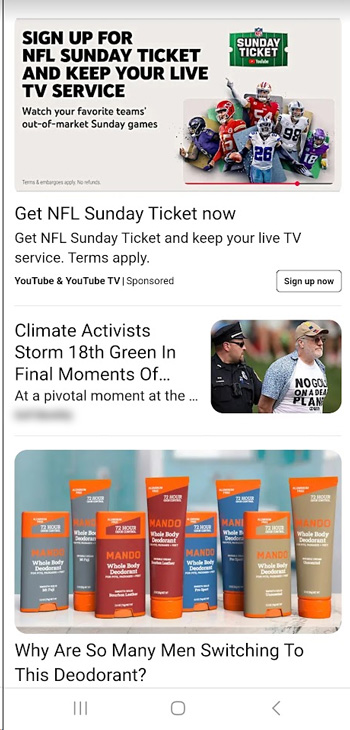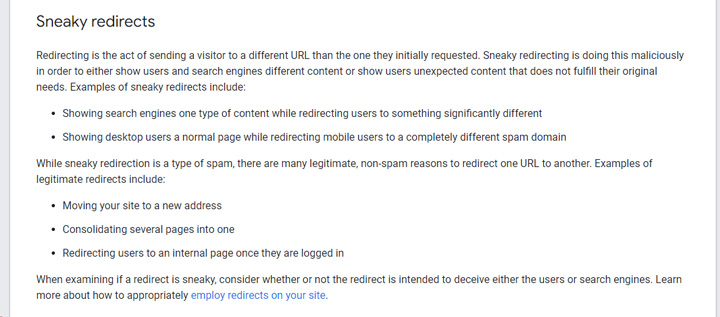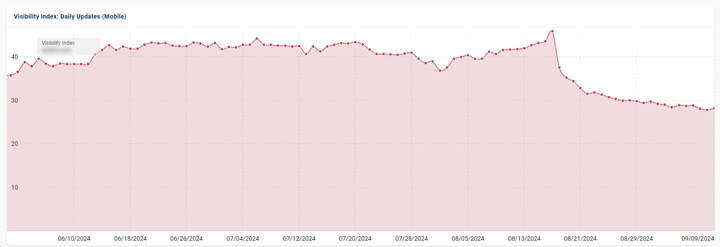

In an effort to keep users on their sites, some publishers have hijacked the browser back button by providing a feed of articles that drives users to more publisher content, including sponsored content and ads. That’s versus allowing them to return to the sites they visited from… Disabling, or hijacking the back button, is a tricky and deceptive tactic, since users might not know they actually stayed on the same site. And that’s especially the case when visitors arrive on the site from Google Discover since the publisher feed looks very similar to the Discover feed.
There are several obvious reasons that some publishers are doing this. Driving users to the publisher’s feed after hitting the back button can yield more pageviews, more ad impressions, and more revenue. But there’s another possible benefit of doing this… It can lead to more engagement for users that remain on the site, even if that’s not what the user intended to do. And with Google’s Navboost system at play, that can potentially be impacting rankings. I’ll cover more about Navboost soon.
On the flip side, hijacking the back button is so sneaky and annoying, that publishers risk angering and frustrating users by doing this. And if that happens, maybe those users don’t want to visit the site next time, maybe they report this is happening, tell friends and family about it, or post about it on social media. Let’s face it… disabling or hijacking the back button is pretty deceptive. I have always said, “Hell hath no fury like a user scorned.”
If you’re not familiar with what the feed looks like after the back button is hijacked, here are some screenshots from a site that is employing this tactic. Looks a lot like Google Discover, right?




Not new, but there’s a new wrinkle…
Hijacking the back button is not new… it’s been around for a while. And when asked about this tactic in the past, and whether Google should do anything about it, Googlers have always said that what’s done beyond the first click from Search is between site owners and their users. Basically, if hijacking or disabling the back button angers users, then you risk them not coming back to your site. So, Google was saying that although you risk angering users, that doesn’t mean Google should issue a manual action or downrank a site algorithmically.
Google’s John Mueller has been asked about this several times in Search Central hangout videos. You can read more about that in a post from Barry Schwartz on Search Engine Roundtable from 2017, and I included one of John’s video below (at 11:55 in the video).
That sort of made sense to me in the past… until we learned about Navboost during the recent antitrust trial. By the way, it ends up that Navboost is something I’ve been writing about since 2013 without knowing the name of the system! Navboost is an important system used by Google that tracks 13 months of user interaction signals and it can impact rankings. This is how Google can understand user happiness, or user frustration, depending on the situation.
Like I said earlier, I have covered for a long time how you don’t want to anger or frustrate users and how that can come back to bite you. In my posts and presentations about major algorithm updates, I have always said, “Hell hath no fury like a user scorned” when referring to a terrible user experience and its impact on SEO. And Navboost can help Google understand that frustration. You can read my post about “Highly visible and low quality” to learn more about Navboost. And there’s also a great post on Search Engine Land from Mario Fischer that covers Navboost.
For example, hammering users with aggressive ads, a terrible UX, aggressive or deceptive affiliate links, and more, can often cause problems for sites when broad core updates roll out. Now, there’s never one smoking gun with core updates, but those are contributing factors (and something I have written about since medieval Panda days). You can read more about core updates in my post covering important tips, faqs, and information.


Gaming Navboost, and should there be a Google spam policy against it?
So how does this all tie together from an SEO standpoint? Well, hijacking or disabling the back button can potentially hack Navboost data (at least a bit). For example, artificially extending a user’s session by presenting that deceptive feed of additional content. And if that’s going on, then it begs the question, should there be a spam policy addressing that? And should Google take action, whether that’s a manual action or an algorithmic demotion?
I mean, if Navboost can be impacted positively, then hijacking the back button is something that can manipulate rankings. In aggregate, strong user interaction signals are a powerful signal to Google about user happiness (or unhappiness). And changes in Navboost scoring can potentially cause a ton of volatility rankings-wise, and possibly a lot of movement during broad core updates when Google updates its core ranking systems. That’s unless Google is already adjusting Navboost scoring if it knows ‘back button hijacking’ is going on. I doubt that’s happening, but it’s possible.
If Navboost wasn’t a thing, and wasn’t an important system to Google, then I would agree that what you do beyond the first click from the SERPs is between you and your users. But if manipulating engagement is impacting rankings (even a little), then maybe Google needs to do something about it.
Manual actions: The easy, but not foolproof, solution.
In my opinion, a wave of manual actions going out for ‘Back button hijacking’ could go a long way to stopping site owners from implementing that functionality. That might scare enough site owners to stop many of them from implementing hijacking. It’s not foolproof since site owners could easily add that functionality back (and in sneaky ways). That’s why an algorithmic approach would be stronger, but again, that may be asking a lot from Google. I recently explained similar things in a blog post about ‘Site reputation abuse’, which is only handled via manual actions for now. That really needs to be algorithmic, and you can learn more about that in my post.
And like I explained earlier, when ‘back button hijacking’ happens for users from Google Discover, it’s even more sinister since the feed that sites are presenting resembles the Discover feed. So someone trying to make their way back to Discover might not even know they are still on the publisher site. Again, more pageviews, more ads, more revenue, and more engagement for Navboost to process.
Note, Google wouldn’t even need to create a new spam policy. There are already policies for “Misleading functionality” and “Sneaky redirects“. And hijacking the back button could fall under either in my opinion.




A Navboost twist: But wait, is hijacking the back button actually providing Navboost with NEGATIVE user experience data? And is it the tip of the iceberg with aggressive ads?
Yep, that would be a twist… Maybe users are so frustrated when the back button is hijacked or disabled that it’s sending terrible user interaction signals to Google… and maybe that’s counterbalancing the increased engagement. And maybe that’s why Google hasn’t done anything yet. Maybe hijacking the back button simply doesn’t work for impacting Navboost data in a meaningful way — other than negatively impacting the signals that Google is seeing.
Over the past several months, I have come across a number of sites that are hijacking the back button. And after reviewing the sites, you could see that hijacking was often the tip of the iceberg from an aggressive monetization standpoint. The sites often had extremely aggressive and disruptive advertising. So I took a quick look at their visibility trending over time. For several of the sites, it wasn’t pretty. I saw big drops during major algorithm updates, including broad core updates.
To clarify, impact from broad core updates is never about one thing. If “Quality” is the issue, there’s never one smoking gun. Google is evaluating sites overall with broad core updates and is taking many factors into account when evaluating quality. Google has explained this and it’s what I have seen while helping companies deal with major algorithm updates over the years. As Google’s John Mueller explained, “Quality” is more than just content.
Actually, I just covered that topic in my latest video podcast. You can view that segment below.
For example, here is trending from a site that’s currently hijacking the back button. Note, this is part of a larger aggressive UX situation (including aggressive and disruptive ads). The site was hit hard by the August core update:


So, I’m not saying that hijacking the back button alone caused a big drop with major algorithm updates, but it could be part of a larger aggressive, disruptive, and deceptive advertising mix that the sites are employing. And that, combined with other factors, could have led to the drops in visibility over time during broad core updates for the sites employing ‘back button hijacking’.
And if that’s the case, is hijacking really worth it?
For site owners hijacking or disabling the back button, listen and watch your users:
If you’re a publisher utilizing this tactic, then you might be wondering how it’s truly impacting the user experience. I’m not referring to skewed ad impression data, which could be misleading, but instead, I’m talking about REAL user data (user happiness).
There is a way to find this out, and it’s something I have covered many times in posts and presentations about major algorithm updates. You can simply run a user study through the lens of core updates to receive objective feedback from third-party users. I’m not referring to your family, friends, or coworkers. I’m referring to real objective users from a panel.


My guess is that you might hear, and watch, extremely frustrated users trying to exit your site. And if that’s what you find, then you might want to reconsider hijacking the back button. I get it, the short-term revenue boost is nice… but the revenue drop of a manual action, or algorithmic action, based on gaming user interaction signals, could be painful. And heck, maybe it’s already causing issues with broad core updates…
Summary: Reevaluating hijacking the back button.
In closing, I have no idea if Google is planning anything to address ‘back button hijacking’, but we did just see three new web spam policies announced right when the March 2024 core update rolled out. I think many people would like to see another spam policy announced for hijacking the back button. And again, there are already policies for “Misleading functionality” and “Sneaky redirects”, which hijacking can fall under. Time will tell if anything happens on that front.
Oh, and if you are planning on returning to a page that sent you to my blog post, rest assured I have not hijacked the back button. You are free to leave. 🙂
GG








